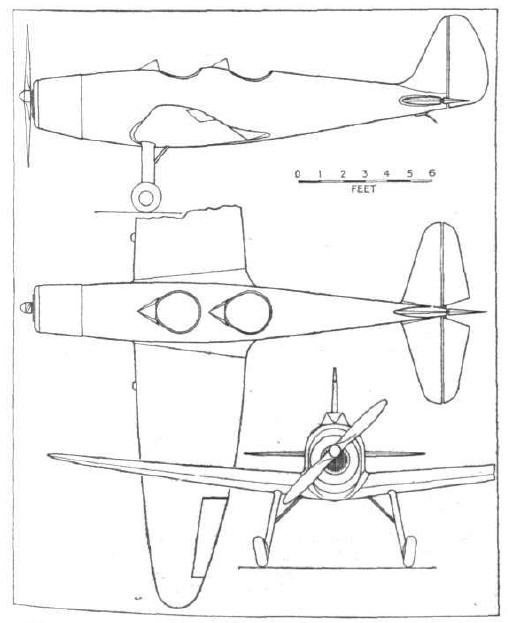CLW Curlew on:
[Wikipedia]
[Google]
[Amazon]
The CLW Curlew was a two-seat, single-engined
"Registration Certificate for ''G-ADYU''"
/ref> It then went to

training aircraft
A trainer is a class of aircraft designed specifically to facilitate flight training of pilots and aircrews. The use of a dedicated trainer aircraft with additional safety features—such as tandem flight controls, forgiving flight characteristic ...
built partly to demonstrate a new wing structure. It flew successfully in the UK in 1936, but the company went bankrupt and only one Curlew flew.
Design and development
In the early 1930s Francis Welham and Arthur Levell conceived a new single spar duralumin wing structure that promised weight savings without loss of strength. It was quite different from the already established Monospar design. The wing was built around a cross braced, girder-like box, with the front and rear members attached to it with cantilever ribs. With financial support from S.W. Cole of EKCO radio, they set up a company known by their initials as CLW Aviation, based atGravesend, Kent
Gravesend is a town in northwest Kent, England, situated 21 miles (35 km) east-southeast of Charing Cross (central London) on the Bank (geography), south bank of the River Thames, opposite Tilbury in Essex. Located in the diocese of Roche ...
and built a wing for testing. This performed to the calculations even under destructive testing, and the company decided to produce a small aeroplane using it. The CLW Curlew was intended both as a demonstrator and as a trainer for those pilots going on to modern, fast monoplanes. It was also seen as a contender in the open two-seater market, particularly for the richer buyer after a machine with "snappier" performance. It made its first flight on 3 September 1936 at Gravesend, flown by the ex- Beardmore pilot A.N. Kingwill.
The Curlew was an all-metal aeroplane, apart from the fabric covering of its elliptical, cantilever wing, and so an unusual light plane for its time. The wing carried short span Frise ailerons outboard. The rest of the trailing edge carried manually operated split flaps. The fuselage was a monocoque structure, built on duralumin ovals and stringers, covered with stress bearing Alclad
Alclad is a corrosion-resistant aluminium sheet formed from high-purity aluminium surface layers metallurgically bonded (rolled onto) to high-strength aluminium alloy core material. It has a melting point of about . Alclad is a trademark of Alcoa ...
sheet. The engine installation was particularly neat for a radial. The 7-cylinder 26.5 in (673 mm) diameter 90 hp (67 kW) Pobjoy Niagara came as a "power-egg
A power-egg is a complete "unitized" Modular design, modular engine installation, consisting of engine and all ancillary equipment, which can be swapped between suitably designed equipment, with standardised quick-changing attachment points and ...
" complete with all accessories and its own long chord cowling, plus Pobjoy's characteristic "smiley" front baffle. The similarity to inline installations was enhanced by the upward off-set of the drive shaft of the two-bladed propeller, caused by the gearbox. The two generous open cockpits were in tandem, the front one at mid wing and the other at the trailing edge. The empennage was conventional: a slender fin carried a rounded, unbalanced rudder which extended down the bottom of the fuselage, and the tapered, mid-fuselage tailplane carried separate elevators so the rudder could move between them. The undercarriage had vertical (in flying position) legs from the wings with a large (3 in or 76 mm) movement, each sloping outwards slightly to increase the track and braced inwards by struts from halfway down the legs to the wing roots.
Sqn Ldr F.W.H.Lervill (another CLW director) had clear ideas on training aircraft and the Curlew was intended to place the pupil at the front to familiarise him or her with the sensation of flying alone. He also chose not to fit wheel brakes, for he thought they were likely to confuse the novice.
After its first flight, the Curlew successfully completed its initial trials, which include a terminal velocity dive at 305 mph (491 km/h) and a maximum loaded weight producing a wing loading of 14 lb/sq ft (68 kg/m2). Landing speed with flaps down was 38 mph (61 km/h). The machine was advertised as suitable for other engines up to powers of 130 hp (97 kW) and the de Havilland Gipsy Major
The de Havilland Gipsy Major or Gipsy IIIA is a four-cylinder, air-cooled, inverted inline engine used in a variety of light aircraft produced in the 1930s, including the famous de Havilland Tiger Moth, Tiger Moth biplane. Many Gipsy Major en ...
was specifically mentioned. Though Cole had by this time withdrawn his financial support, things for a short while looked bright for CLW, with talk of an Australian order for 50 Curlews, but they were over extended and went bankrupt. Plans for a twin-engined light transport using a similar wing structure were abandoned. The sole Curlew, registered ''G-ADYU'' and built at a cost of £10,000 went to Essex Aero
Essex Aero Ltd. was an aircraft maintenance and component manufacturer, primarily based at Gravesend Airport in Kent, from 1936 to 1953.
Founded by Jack Cross, it is most famous for its rebuilding work on de Havilland DH.88 Comet racer G-ACSS a ...
, also of Gravesend, in the asset sale./ref> It then went to
Martlesham Heath
Martlesham Heath is a village in Suffolk, England. It is east of Ipswich, This was an ancient area of heathland and latterly the site of Martlesham Heath Airfield. A "new village" was established there in the mid-1970s and this has developed in ...
and gained its Certificate of Airworthiness on 19 November 1936. It seems to have done little flying after that, and was put up for sale in July 1938. Stored during the war, it was broken up in 1948.
Specifications

References
Citations
Cited sources
* * * * * {{refend 1930s British aircraft Aircraft first flown in 1936 Low-wing aircraft Single-engined tractor aircraft